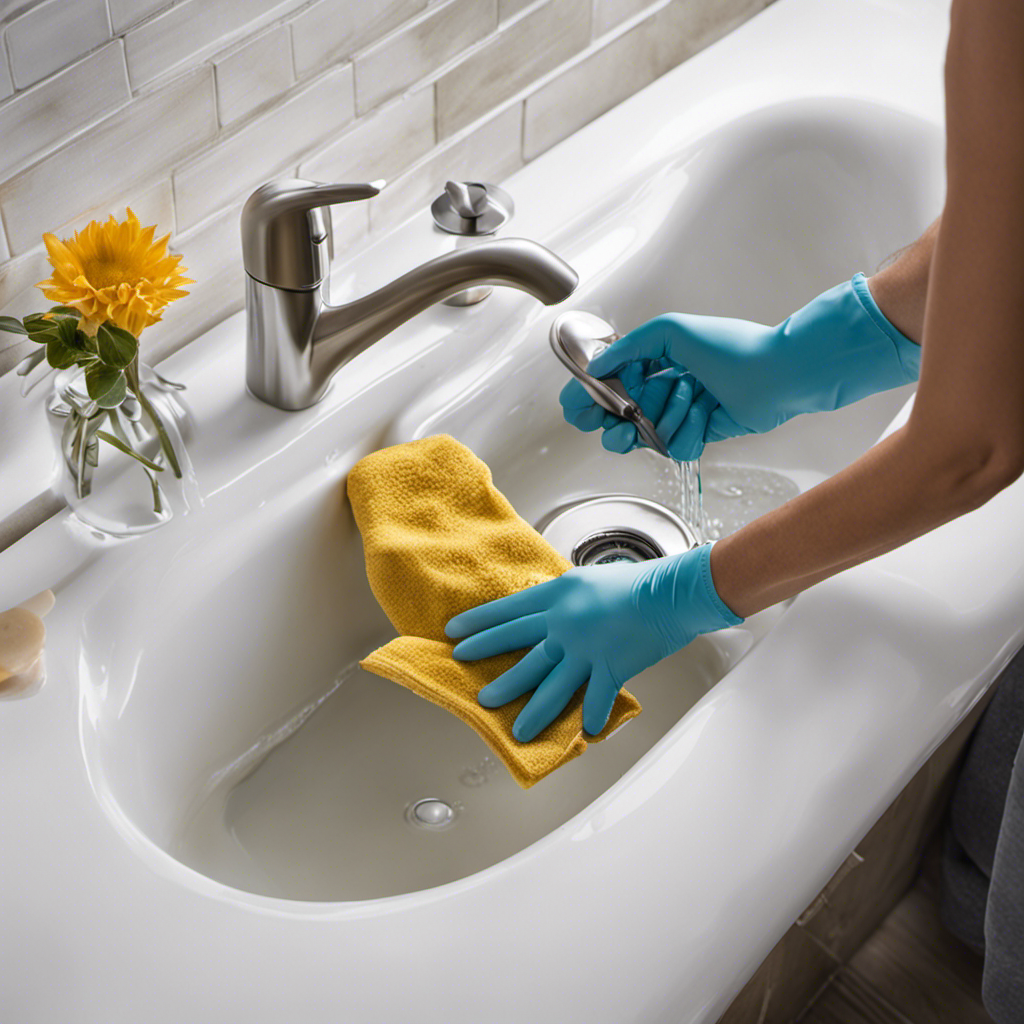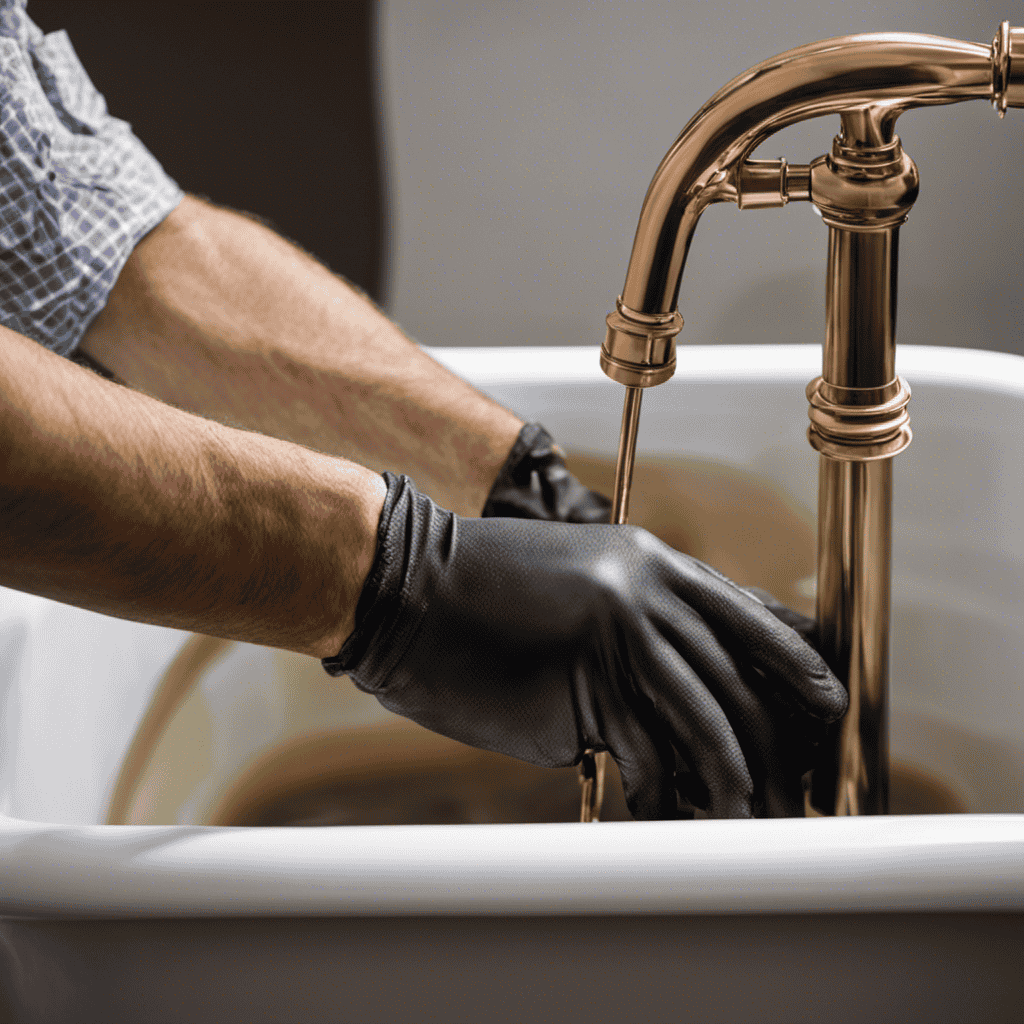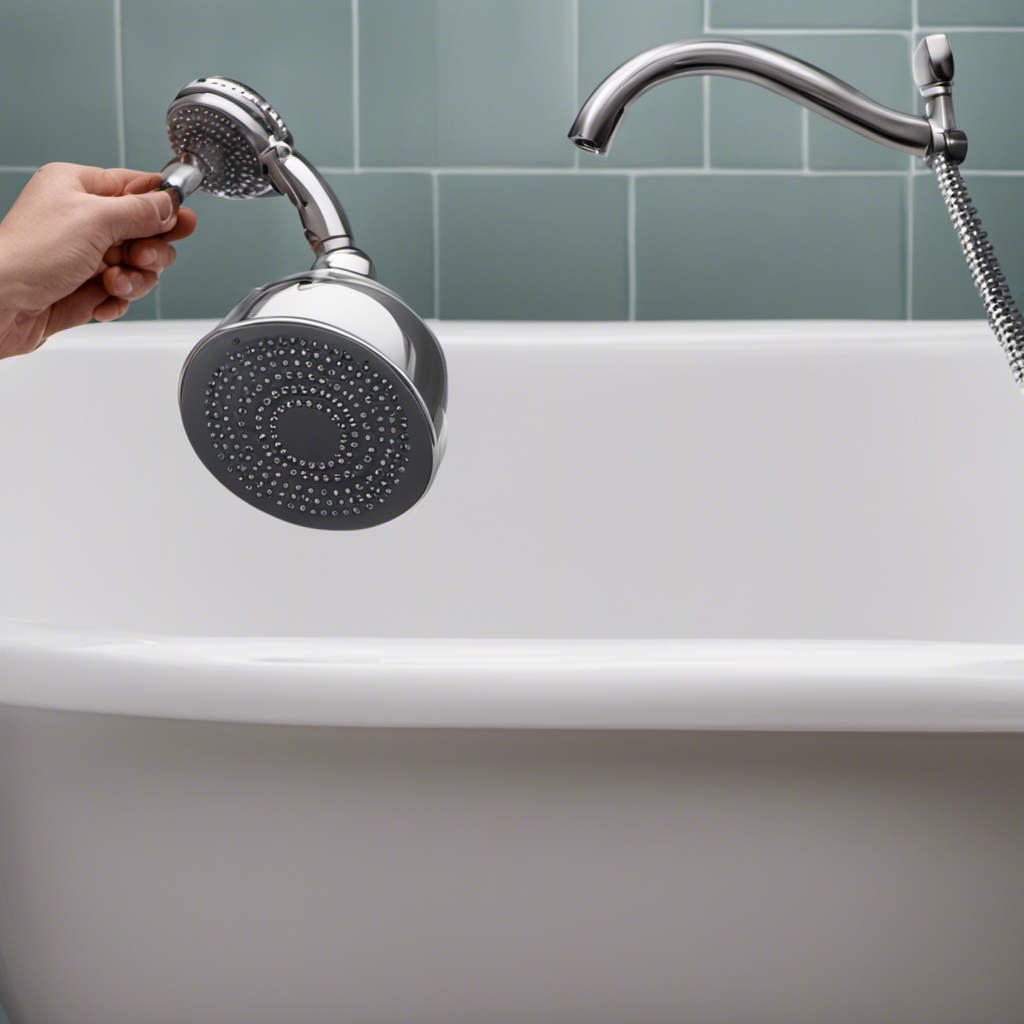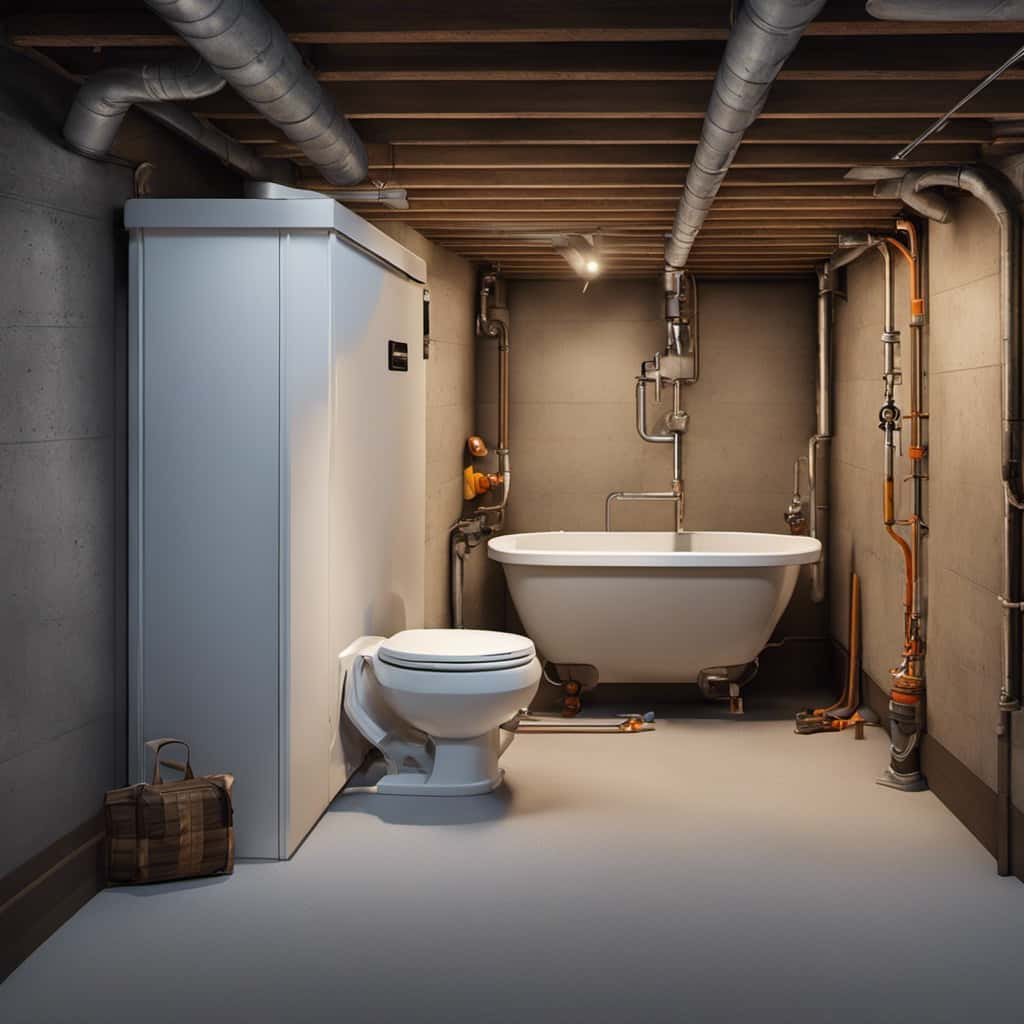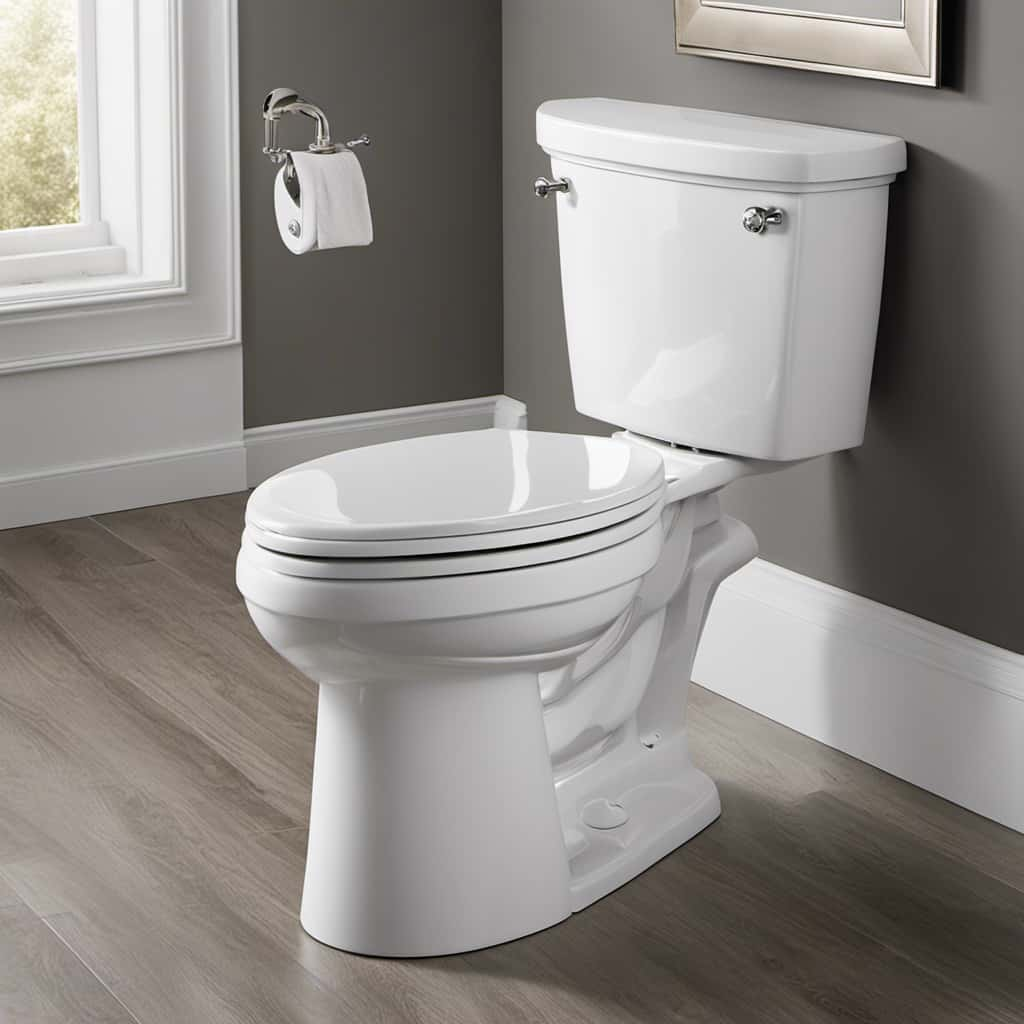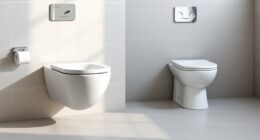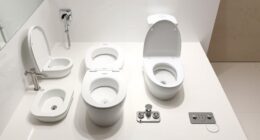Are you tired of stepping into a grimy and dirty bathtub every day? Look no further!
This article will show you how to clean your dirty bathtub and restore it to its sparkling glory.
With just a few simple steps and some common cleaning supplies, you’ll be able to scrub away those stubborn stains and enjoy a fresh and rejuvenating bathing experience.
Say goodbye to dirt and grime, and say hello to a clean and inviting bathtub!
Key Takeaways
- Assess the level of dirtiness and prepare the bathtub for cleaning by examining the surface, removing loose debris, and rinsing with warm water.
- Gather eco-friendly cleaning supplies, including protective gloves, scrub brush or sponge, cleaning solution, and a microfiber cloth.
- Use effective scrubbing techniques and specific cleaning solutions to tackle stains and grime on the bathtub surface.
- Rinse the bathtub, dry it thoroughly, and prevent water streaks to maintain a clean and hygienic bathroom space.
Assessing the Level of Dirtiness
You’ll want to take a close look at the bathtub to see how dirty it is. Evaluating cleanliness is the first step in effectively cleaning a dirty bathtub. Start by examining the surface for any visible dirt, grime, or soap scum buildup. Pay attention to corners, edges, and the drain area. If there are any stains or discoloration, take note of them as well.
This assessment will help you determine the level of cleaning required. Once you have evaluated the dirtiness, you can move on to removing grime. This may involve scrubbing with a cleaning solution, using a brush or sponge, and applying some elbow grease. By removing the grime effectively, you’ll be one step closer to a sparkling clean bathtub.
Now, let’s move on to gathering the necessary cleaning supplies.
Gathering the Necessary Cleaning Supplies
Make sure to gather all the necessary cleaning supplies before starting. First, choose eco-friendly products to minimize harm to the environment. Look for cleaning solutions that are labeled as biodegradable or non-toxic.
Additionally, using protective gloves is essential to protect your hands from harsh chemicals and bacteria. Rubber gloves are a good option as they provide a barrier between your skin and the cleaning agents.
Other supplies you will need include a scrub brush or sponge, a bucket or spray bottle for the cleaning solution, and a microfiber cloth for drying. Having all these items ready beforehand will make the cleaning process more efficient and ensure that you have everything you need to tackle the dirty bathtub.
Preparing the Bathtub for Cleaning
Before starting, it’s important to ensure that the bathtub is properly prepared for cleaning. You need to evaluate its cleanliness and remove any debris that may be present. To make this process easier, here’s a simple table to guide you:
| Step | Action |
|---|---|
| 1 | Inspect the bathtub’s surface for any visible dirt or grime. |
| 2 | Remove any loose debris such as hair, soap scum, or dirt using a brush or sponge. |
| 3 | Rinse the bathtub with warm water to remove any remaining residue. |
Scrubbing and Removing Stains
When it comes to scrubbing and removing stains from your bathtub, there are a few key points to keep in mind.
First, it’s important to choose the best cleaning solutions for the job, such as those specifically designed for tackling tough bathroom grime.
Second, effective scrubbing techniques can make all the difference in getting your bathtub sparkling clean.
And finally, for those stubborn stains that just won’t budge, there are specific strategies you can use to tackle them head-on.
Best Cleaning Solutions
To effectively clean your dirty bathtub, you’ll need to try out the best cleaning solutions available. When it comes to tackling bathtub grime, natural cleaning methods and DIY solutions can be highly effective.
One popular option is a mixture of baking soda and vinegar. Simply sprinkle baking soda over the surface of the tub, then spray vinegar on top. Let the mixture sit for a few minutes before scrubbing with a brush or sponge.
Another great option is a paste made from hydrogen peroxide and cream of tartar. This powerful combination can help remove tough stains and leave your bathtub looking sparkling clean.
Remember to always test any cleaning solution on a small, inconspicuous area before applying it to the entire tub.
Effective Scrubbing Techniques
Now that you have the best cleaning solutions, let’s move on to effective scrubbing techniques. These will help you tackle that dirty bathtub with ease and save you valuable time. Here are some tips to make your scrubbing more efficient:
-
Use the right cleaning tools: Invest in a good quality scrub brush or sponge with sturdy bristles to effectively remove grime and stains.
-
Apply a cleaning agent: Before scrubbing, spray or apply your chosen cleaning solution onto the surface of the bathtub. Let it sit for a few minutes to loosen dirt and make scrubbing easier.
-
Scrub in circular motions: Start scrubbing in small, circular motions to cover the entire surface area. This technique helps to dislodge dirt and grime more effectively.
Tackling Stubborn Stains
It’s important to target stubborn stains with a powerful cleaning agent to effectively remove them. When it comes to tackling tough bathtub stains, using the right cleaning products is key. Look for cleaners specifically designed for removing stains and grime from bathtubs. These products usually contain strong chemicals that can break down and dissolve stubborn stains.
Apply the cleaning agent directly to the stain and let it sit for a few minutes to penetrate and loosen the dirt. Then, scrub the area with a brush or sponge to remove the stain. For time-saving hacks, consider using a homemade cleaning solution made with ingredients like vinegar or baking soda. These natural cleaners can be just as effective at removing stains without the harsh chemicals.
Rinsing and Drying the Bathtub
When it comes to properly drying your bathtub, there are a few key techniques to keep in mind.
First, make sure to use a clean, dry cloth or towel to wipe down the tub surface thoroughly. This will help prevent water streaks and ensure a sparkling clean finish.
Proper Drying Technique
After rinsing the bathtub thoroughly, make sure to use a clean towel to dry it completely. Proper drying technique is crucial to prevent mold growth and keep your bathtub clean and healthy. Here are some tips to help you dry your bathtub effectively:
- Use a microfiber towel: Microfiber towels are highly absorbent and can quickly soak up excess water from the surface of the bathtub.
- Start from the top: Begin drying from the top of the bathtub and work your way down to ensure that no water streaks or droplets are left behind.
- Pay attention to corners and crevices: These areas tend to trap moisture, so make sure to dry them thoroughly to prevent mold and mildew growth.
By following these drying techniques, you can prevent mold growth and maintain a clean and hygienic bathtub.
Now, let’s move on to the next section about preventing water streaks.
Preventing Water Streaks
To avoid water streaks, wipe the surface of your tub with a microfiber towel in a gentle, circular motion. This technique helps to prevent water spots from forming on your tub.
Additionally, using natural cleaning agents can further aid in the prevention of water streaks. Natural cleaning agents, such as vinegar or lemon juice, can be mixed with water to create a homemade cleaning solution. These agents are effective at breaking down soap scum and mineral deposits, leaving your tub clean and streak-free.
When using the cleaning solution, make sure to apply it evenly across the surface of the tub and rinse thoroughly with water.
Maintaining a Clean Bathtub
It’s important to regularly clean your bathtub to maintain a clean and hygienic bathroom space. Bathtub maintenance is essential for preventing soap scum buildup and keeping your tub looking fresh.
Here are some tips to help you in maintaining a clean bathtub:
- Use a non-abrasive cleaner: Choose a cleaner specifically formulated for bathtubs to effectively remove soap scum without damaging the surface.
- Scrub regularly: Develop a cleaning routine and scrub your bathtub at least once a week to prevent soap scum from accumulating.
- Rinse thoroughly: After each use, make sure to rinse the bathtub with warm water to remove any soap residue that may lead to soap scum buildup.
Frequently Asked Questions
Can I Use Bleach to Clean My Bathtub?
Yes, you can use bleach to clean your bathtub. Bleach is effective at killing germs and removing stains. However, it can be harsh on surfaces and emit strong fumes, so use it with caution and proper ventilation.
How Often Should I Clean My Bathtub?
You should clean your bathtub regularly to maintain its cleanliness and prevent the buildup of grime and bacteria. Scrubbing it once a week is a good idea. Using a bathtub cleaner is not always necessary, but can be helpful for tough stains.
What Should I Do if There Is Mold in My Bathtub?
To remove stubborn stains and prevent mold growth in your bathtub, start by addressing the mold issue. Use a mixture of bleach and water to scrub away the mold. Then, regularly clean your bathtub to prevent future mold growth.
Can I Use Vinegar as a Substitute for a Commercial Cleaning Product?
If you’re looking for an alternative cleaning method, vinegar can be a great substitute for commercial products. Not only does it save you money, but it also has the added benefits of being natural and environmentally friendly.
Is It Necessary to Wear Gloves While Cleaning the Bathtub?
When cleaning your bathtub, it’s important to wear gloves for protection. As for the tools, a scrub brush is great for removing tough stains, while a sponge works well for regular cleaning. Hydrogen peroxide can safely be used to clean the bathtub.
Conclusion
Now that you’ve followed these simple steps to clean your dirty bathtub, you can finally enjoy a sparkling and fresh bathing experience.
First, assess the level of dirtiness and gather the necessary cleaning supplies. This will help you prepare the bathtub for a thorough scrubbing.
Next, remove stains and rinse the bathtub to ensure that it is free from any grime or residue. This step is crucial in achieving a clean and shiny bathtub.
Lastly, remember to maintain a clean bathtub to avoid future dirt build-up. Regular cleaning will help keep your bathtub looking its best.
So go ahead, relax, and indulge in a luxurious bath that will leave you feeling refreshed and rejuvenated.

